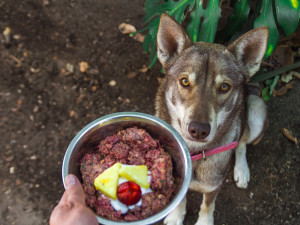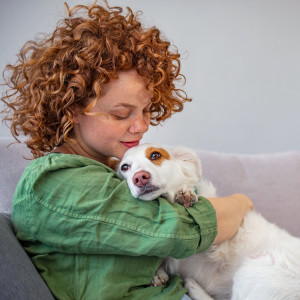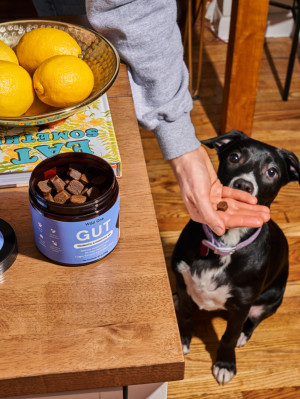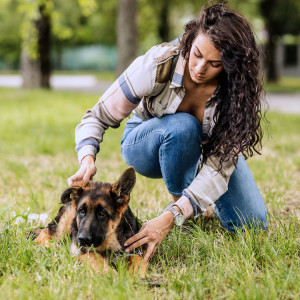Salmonella in Dogs: Can Dogs Get Salmonella?
What to look out for if they are sick from this bacteria.
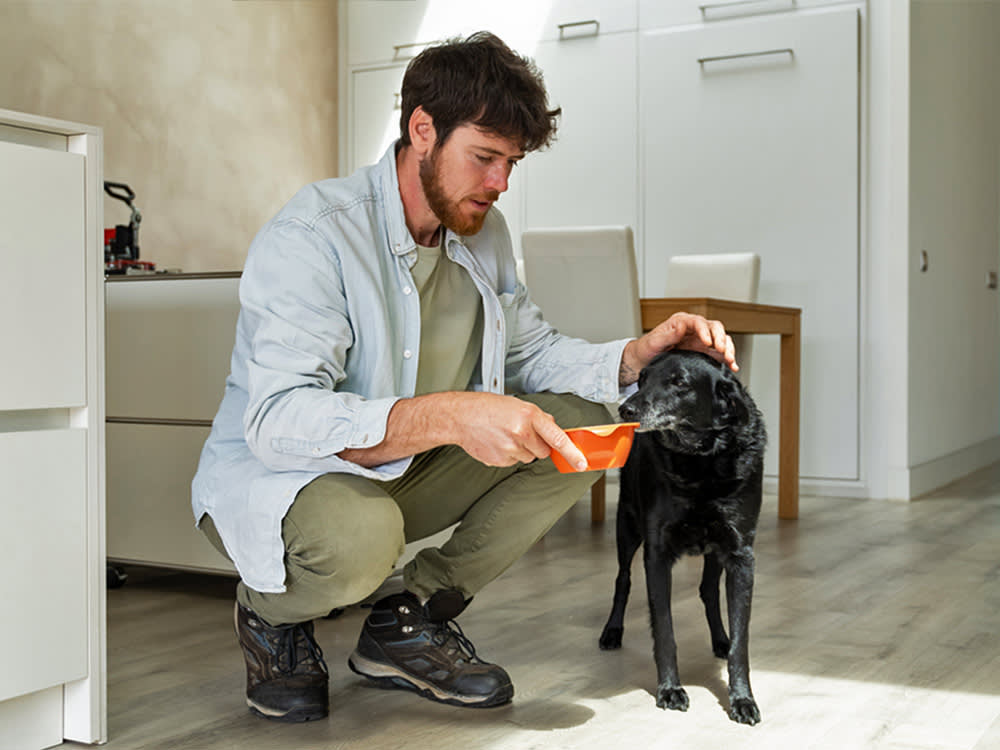
share article

Your pet wants you to read our newsletter. (Then give them a treat.)
In This Article:
Causes of Salmonella in Dogs opens in a new tabSalmonella Symptoms in Dogsopens in a new tab How to Treat Salmonella in Dogs opens in a new tabFrequently Asked Questionsopens in a new tab
Dogs can contract salmonella, but they are generally more resistant to infection than humans. Signs of infection usually include digestive upset, especially diarrheaopens in a new tab. Many dogs with salmonella don’t have any symptoms at all; however, they can still shed the bacteria and potentially infect other pets and people in the home.
Salmonella transmission to dogs usually occurs through contaminated food, water, or contact with infected animals. Pet parents should prioritize safe handling practices, provide a balanced diet, and maintain good hygiene to minimize the risk of salmonella transmission to or from their canine companions.
Yes, dogs can and do become infected with the bacteria Salmonella enterobacteriaceae. Healthy adult dogs tend to be more resistant to the infection when compared to humans and some other animals; however, dogs who are especially young, old, or immunocompromised are at higher risk for infections. The kicker is that many dogs with salmonella have no physical signs of illness, so pet parents often have no clue that their dogs are infected.
And this matters because even though your dog may not have any signs of infection, they can still shed the bacteria, putting other pets and people at risk for getting infected from them. Therefore, even though you don’t have to worry too much about your dog getting seriously ill from Salmonella, you should take every precaution to prevent your dog from being exposed to Salmonella and becoming a possible super-spreader.
Causes of salmonella in dogs
Salmonella is a bacteria from the family Enterobacteriaceae. Some animals are natural carriers of the bacteria and do not get sick from Salmonella, including cows, chickens, rodents, reptiles, and amphibians.
People and animals who do get sick from Salmonella are often exposed to the bacteria from contact with these carrier animals, as well as through contaminated food, water, or soil. If they come into contact with these contaminated materials and then ingest them or touch their mouths, the bacteria can enter their digestive tract and wreak havoc.
Common salmonella-contaminated foods
Contaminated foods are a common source of Salmonella bacteria. Often this includes foods that come from animals known to carry the bacteria, like chickens and cows. So, your mom was right-on when she told you not to lick the spoon with raw cookie dough on it. Other foods, even raw fruits and vegetables, can also be contaminated. Some of the common culprits include:
Raw eggs
Because chickens are known carriers of Salmonella, any products that come from chickens carry that risk.
Raw chicken
Raw chicken is a common source of exposure to Salmonella. The meat should be cooked to an internal temperature of at least 165 degrees Fahrenheit to ensure the bacteria is killed. Be sure to carefully wash your hands and disinfect all surfaces that come into contact with raw meat.
Raw pet food diets
Not surprisingly, raw pet food opens in a new tabdiets are also a source of Salmonella. Because these diets are not heated to kill bacteria, the food is at higher risk of contamination. This means pets can be exposed along with people in the home who are in contact with the food, the bowls, and the pets.
Salmonella symptoms in dogs
Many dogs with salmonella infections will be asymptomatic, meaning they do not show any signs of illness at all. They may be shedding the bacteria in their saliva and/or poop, however. For dogs who do get sick from the bacteria, the signs are often related to digestive upset. This is because the bacteria enter through the mouth and make their way to the intestines where they settle in and cause destruction.
The most common signs of a salmonella infection in dogs include:
Diarrhea
Diarrhea is the most common sign of a Salmonella infection. Dogs may strain to poopopens in a new tab, have urgent episodes that result in accidents, and there may be mucus or blood in the diarrhea.
Loss of appetite
Inflammation and irritation caused by the bacteria can lead to nausea and pain, leading dogs to have a decreased appetite and/or not want to eat at all.
Dehydration
The combination of diarrhea and decreased appetite puts dogs at high risk for becoming dehydrated. They may be losing a lot of fluids through their diarrhea and not replacing them adequately with food and water.
Lethargy
Dogs whoare in pain, nauseous and/or dehydrated often have low energy. They may not be interested in going on walks, playing, or even snuggling. Some dogs may hide or just avoid socializing when they are feeling this way.
Fever
Infections can result in a fever which is part of the immune system’s response to an unwelcome invader. It can be difficult to tell if your dog has a feveropens in a new tab, because they typically have a slightly higher body temperature than we do and usually feel warm to the touch. Your veterinarian can check their temperature to confirm if they have a true fever.
Painful belly
The inflammation caused by these bacteria can lead to abdominal pain and cramping. Your dog may groan or react to being lifted up, and/or avoid their usual activities as a result.
Weight loss
Prolonged diarrhea and decreased appetite can lead dogs to lose weight as well.
How to threat salmonella in dogs
Getting a confirmed diagnosis of salmonella in dogs can be tricky. Because some dogs carry it and don’t have symptoms, finding the bacteria in a dog’s poop does not always mean it is the cause of their current bout of illness. Also, some dogs may have false-negative results if there are other kinds of microbes present at the same time. Most times, you won’t know if your dog has salmonella, or something else causing their signs.
Dogs with mild symptoms of digestive upset, such as diarrhea and a decreased appetite, are treated to relieve their symptoms without necessarily getting a specific diagnosis. This may include giving fluids to help hydrate them, medications to reduce nausea, and other medications to soothe their digestive tract and resolve their diarrhea. For dogs that have more severe symptoms, they may require hospitalization so that these treatments can be given intravenously over a few days.
How to treat salmonella in dogs at home
It would be highly unlikely for you to know for certain that your dog has salmonella without advanced testing performed by a vetopens in a new tab. However, if your dog has mild signs of general digestive upset, such as soft stool, diarrhea, or a mildly decreased appetite, you can try some at-home treatments to soothe their digestive tract and get them feeling better.
If their signs become more severe or they don’t respond to your treatments within 24 hours, it’s important to see a vet for more targeted treatments. Here are some common remedies for mild digestive upset:
Try a bland diet: A mix of steamed white meat chicken (with no skin, bones, or seasoning) combined with cooked white rice opens in a new tabcan be easier to digest when the digestive tract is inflamed. Home-cooked chicken may also be more tempting to a dog with a decreased appetite. Offer small portions at first, smaller than your dog’s typical feedings, to ensure they tolerate it OK.
You can start with three to four small feedings a day and then slowly increase the size of each feeding, as long as your dog can handle it. The goal is to gradually transition them back to their balanced dog food diet after three to five days, so start mixing their regular dog food in gradually once their signs are improving. If your dog is not improving within this three to five day window, head to the vet.Give your dog probiotics: Probiotics are the microbes that colonize the gut opens in a new taband provide many important health benefits. They can prevent harmful germs like Salmonella from colonizing the gut, and may shorten the duration of symptoms like diarrheaopens in a new tab. Be sure to purchase probiotics meant for dogs from a reputable source, as some products are not as effective as others.
Keep your pup hydrated: If your dog is having diarrhea and not eating as much as normal, it’s important to do your best to keep them hydrated. Be sure to offer them water every few hours and keep the bowl within reach all day. You can even offer them some low-sodium chicken broth to get fluids into them, as long as the ingredients don’t include any unsafe foods like onions or garlicopens in a new tab.
You can try mixing some additional water into their wet food if they’ll eat it, or try some chicken-flavored baby food that has a higher moisture content. If your dog is not interested in any of these, head to your vet to prevent more severe dehydration.Limit kissing: This is more for you and your other family members and pets, but it is a good reminder that some causes of diarrhea and digestive upset can be contagious to people and other pets. Be sure to clean up any poopopens in a new tab, especially accidents indoors, quickly and thoroughly, and properly disinfect the area.
Thoroughly wash your hands and all of your pets’ food and water bowls frequently to reduce contamination. And even though it's so hard to resist those slobbery kisses, try not to let your dog lick you or kiss your face,opens in a new tab especially while they are sick.
When to bring your dog to the vet
Any dog with signs like a decreased appetite and diarrhea should be seen by a vet if their signs last more than 12 hours. And they should be seen right away if they have more concerning signs like: blood in the diarrheaopens in a new tab, frequent accidents, not eating at all, are very lethargic, are unable to get up, have a painful belly, are vomiting, or have difficulty breathing.
Dogs who are having large amounts of diarrhea are at risk for becoming dehydrated, so it is important to seek treatment sooner if they are not eating or drinking. Your vet also has access to more effective medications that will help bring them relief from their nausea, pain, and/or lack of appetite, so better to get them treated sooner so they can start feeling better ASAP.
FAQs (People also ask):
How can you tell if your dog is sick?
Signs that your dog is sick opens in a new tabcan include obvious physical changes, like vomiting, diarrhea, coughing, sneezing, trouble breathing, limping, or other abnormalities in their appearance or health. Sometimes, the signs seem more behavioral, such as hiding, avoiding affection, not wanting to play, or acting very lethargic. Any of these would be reasons to see a vet.
What foods should dogs avoid?
There are many foods that you should not share with your dog. Some may actually be toxicopens in a new tab, while others are unhealthy, and still others may put them at risk for choking, internal injuries, and/or infections. Be sure to double-check with your vet if you are unsure what foods are safe for your dog.
References:

Dr. Amy Fox, DVM
Amy Fox, DVM is a small animal veterinarian in New York City. A lifelong animal lover, Dr. Fox studied biology in college and then worked as a veterinary nurse before pursuing veterinary school at Cornell University. She has worked in many different settings including shelter medicine, emergency medicine, general practice, and animal cruelty and forensics. She is especially interested in nutrition, preventative medicine and care for senior pets. Dr. Fox also enjoys writing about veterinary medicine and teaching. In her free time she loves to cook, garden, and go for long runs.
Related articles
![Woman with her dog relaxing in living room.]() opens in a new tab
opens in a new tabHow to Tell If Your Dog Is Sick
Look out for these warnings signs so you know when to call the vet.
![Black dog sitting beneath a table being fed a Wild One GUT supplement]() opens in a new tab
opens in a new tabBest Probiotics for Dogs
Your pup should keep these in their medicine cabinet.
![Young woman comforting German Shepherd puppy outside.]() opens in a new tab
opens in a new tabMy Dog Is Pooping Blood: What Should I Do?
It’s an alarming sight, but here’s what you should know.
